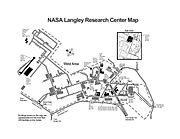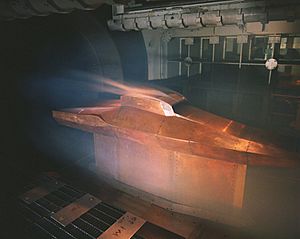Langley Research Center facts for kids
 |
|
 Aerial view of NASA Langley in 2011 |
|
| Agency overview | |
|---|---|
| Formed | 1917 |
| Preceding agency |
|
| Jurisdiction | US Federal Government |
| Headquarters | Hampton, Virginia, United States |
| Employees | 1,821 (2017) |
| Agency executives |
|
| Parent agency | NASA |
| Map | |

Map of NASA Langley Research Center
|
|
The Langley Research Center (often called NASA Langley or LaRC) is the oldest of NASA's main research centers. It is located in Hampton, Virginia, in the United States. The center is next to Langley Air Force Base and the Back River, which flows into the Chesapeake Bay.
NASA Langley mostly focuses on studying and improving things that fly, like airplanes and spacecraft. This is called aeronautical research. They have also tested parts for space missions, such as the Apollo Lunar Module. Many early, important space missions were planned and designed here. For a while, Langley was even considered as the main place for NASA's human spaceflight programs, before Houston was chosen.
The center was started in 1917 by the National Advisory Committee for Aeronautics (NACA). Today, about two-thirds of its work is on aeronautics (flight) and the rest is on space exploration. Scientists and engineers at LaRC use more than 40 wind tunnels. These tunnels help them study how air moves around aircraft and spacecraft. This research helps make flying safer, better, and more efficient. From 1958 to 1963, when NASA took over from NACA and started Project Mercury (the first US human spaceflight program), LaRC was the main office for the team that managed these missions.
In September 2019, Clayton P. Turner became the director of NASA Langley. He had worked there for many years before that.
Contents
History of NASA Langley
Around 1916, the United States was getting ready to join World War I. People realized that the country's military airplanes were not as good as those in Europe. To fix this, President Woodrow Wilson ordered the creation of the nation's first laboratory for studying flight. This became NASA Langley.
In 1917, the NACA started the Langley Memorial Aeronautical Laboratory. Both the laboratory and the nearby Langley Field were named after Samuel Pierpont Langley, an early aviation pioneer. Research began in 1920 with a small team of researchers and technicians.
As air power became more important during World War I, Langley Field and NACA grew together. The center was first set up to study how aircraft bodies and engines work. In 1934, the world's largest wind tunnel was built at Langley Field. It was big enough to test full-sized airplanes! This tunnel remained the largest until the 1940s.
From 1943 to 1958, a group of African American women worked at Langley Research Center as "human computers." They were called the West Area Computers. They did complex math calculations by hand to help with flight research. At the time, laws in Virginia separated people by race. These women worked in the "West Area" of Langley, while white mathematicians worked in the "East section."
In 1945, Langley began to include rocket research. This led to the creation of a flight station at Wallops Island, Virginia. As rocket research grew, Langley also continued its work on aeronautics. They helped advance slower-than-sound flight and introduced faster-than-sound flight.
Langley Research Center has achieved many important "firsts." These include:
- Developing the idea of special research aircraft that led to supersonic flight (faster than sound).
- Creating the world's first wind tunnels that could test things at transonic speeds (near the speed of sound).
- Training the first groups of astronauts.
- Building the Lunar Landing Facility, which helped astronauts practice landing on the Moon by simulating its gravity.
- Working on the Viking program, which sent spacecraft to explore Mars.
The center also developed important standards for adding grooves to airport runways. These grooves, based on a British design, help airplane tires grip the runway better in heavy rain, preventing them from sliding on water. This grooving is now used on runways all over the world.
Langley was also considered as the site for NASA's Mission Control, where space missions are managed. Langley was very important to NASA at the time, and the area already had many aerospace companies. However, Houston was eventually chosen. This decision surprised many people at Langley and caused some disappointment because many jobs moved to Houston. Even though they didn't get Mission Control, Langley still played a big role in research and training for the Apollo Moon missions.
Aeronautics Research
Langley Research Center does very important research on things that fly. This includes studying:
- Wake turbulence: The swirling air left behind an airplane.
- Fixed-wing aircraft: Regular airplanes with wings that don't move.
- Rotary wing aircraft: Helicopters, which have spinning blades.
- Aviation safety: Making sure flying is safe.
- Human factors: How people interact with aircraft and systems.
- Aerospace engineering: The design and building of aircraft and spacecraft.
LaRC helped design and test the X-43, a special experimental aircraft. The X-43 set a world speed record by flying at Mach 9.6 (nearly 10 times the speed of sound!). Langley also helped investigate the crash of American Airlines Flight 587.
In 2011, work began to remove a large 16 feet (4.9 m) transonic wind tunnel that was built in the 1940s. This tunnel helped develop many military fighter jets since 1960. Even though that tunnel was removed, Langley still has other advanced wind tunnels for testing, like the National Transonic Facility. This facility is a high-pressure, super-cooled wind tunnel that is 8.2 feet (2.5 m) wide.
Making New Materials and Parts
Langley Research Center also works on new ways to make strong and useful parts for aircraft and spacecraft.
Electron Beam Freeform Fabrication (EBF³)
The EBF³ process is a special way to create strong metal parts. It can build parts directly from computer designs without needing molds. This method uses a powerful electron gun that melts metal wires, like aluminum or titanium, very quickly. The melted metal is then shaped into the desired 3D part. The parts made this way are very strong and have no tiny holes inside them. This process is much faster than older methods.
Plastic Fabrication
LaRC also has many machines that work with plastics. These machines are used to quickly make low-cost plastic parts for toys, models, and industrial uses. Like the EBF³ process, these machines use computer designs to create parts. Instead of an electron beam, they use a heated element to melt the plastic.
Astronautics Research
Moon Exploration

Since the start of Project Gemini (an early space program), Langley has been a place for astronauts to train for meeting up with other spacecraft in space. In 1965, Langley opened the Lunar Landing Research Facility. This facility had a giant gantry (a frame with a platform) over a fake Moon landscape. A model of the Apollo Lunar Module was hung from the gantry. This allowed astronauts to practice landing on the Moon by simulating its gravity. They also did experimental work with special Lunar Landing Research Vehicles.
Mars Exploration
Langley Research Center has also helped with NASA's missions to Mars. For example, they helped design spacecraft for landing on Mars, like the Mars Exploration Rover.
Earth Science
Langley Research Center also does important Earth science research. This work helps NASA understand our planet better.
Awards and Achievements
Scientists and engineers from Langley Research Center have won the Collier Trophy five times. This award is given for major achievements in aerospace. Some of their winning achievements include:
- In 1929, for developing a way to reduce drag on airplane engines.
- In 1946, for creating an effective system to de-ice airplane wings.
- In 1947, for research that helped understand the rules of supersonic flight.
- In 1951, for developing and using a special "slotted-throat" wind tunnel.
- In 1954, for developing the Whitcomb area rule. This was a simple but powerful method to greatly reduce the drag that airplanes experience when flying near the speed of sound. This discovery made it much easier for planes to reach supersonic speeds.
See also
 In Spanish: Centro de investigación de Langley para niños
In Spanish: Centro de investigación de Langley para niños





